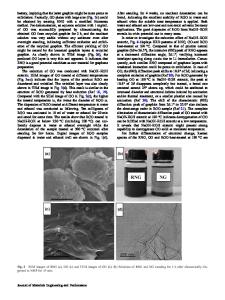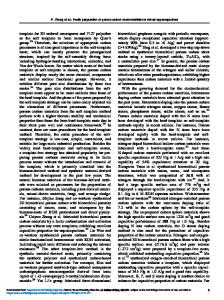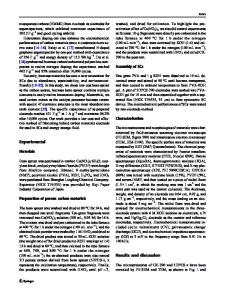Porous carbon nanosheets derived from expanded graphite for supercapacitors and sodium-ion batteries
- PDF / 5,255,856 Bytes
- 11 Pages / 595.276 x 790.866 pts Page_size
- 97 Downloads / 615 Views
Porous carbon nanosheets derived from expanded graphite for supercapacitors and sodium-ion batteries Chang Ma1,2 Jingli Shi1,*
, Qingchao Fan1, Mahmut Dirican2, Yan Song3, Xiangwu Zhang2,*, and
1
Tianjin Municipal Key Lab of Advanced Fiber and Energy Storage Technology, Tiangong University, Tianjin 300387, China Fiber and Polymer Science Program, Department of Textile Engineering, Chemistry and Science, Wilson College of Textiles, North Carolina State University, Raleigh, NC 27695-8301, USA 3 CAS Key Laboratory of Carbon Materials, Institute of Coal Chemistry, Chinese Academy of Sciences, Taiyuan 030001, China 2
Received: 10 June 2020
ABSTRACT
Accepted: 21 August 2020
Two-dimensional carbons have attracted extensive interest in the field of energy storage and conversion owing to their unique nanostructure, high aspect ratios, and abundant surface-active sites. In this work, carbon nanosheets with developed porosity and high specific surface area were fabricated from expanded graphite (EG) by a siliconization/chlorination strategy. The worm-like macroporous structure and nanosheet morphology of EG are inherited by the resultant carbon nanosheet. The siliconization/chlorination strategy creates abundant micropores in EG, endowing the as-obtained carbon nanosheet with a high specific surface area of 1229 m2 g-1 and a total pore volume of 0.75 cm3 g-1. With high specific surface area, nanosheet morphology, and macroporous structure, the EG-based carbon nanosheet presents excellent performance when used as electrode materials of supercapacitors and sodium-ion batteries. When used as an electrode of supercapacitors, it delivers a specific capacitance of 210 F g-1, retains 62% of the initial capacitance with increasing current density from 0.1 to 30 A g-1, and maintains 98.6% of the initial capacitance after 5000 cycles. When used as the anode of sodium-ion batteries, it presents a reversible capacity of 198 mAh g-1 at 0.1 A g-1 and maintains 65 mAh g-1 after 1000 cycles at 5 A g-1. The proposed strategy could be extended to other sp2 carbon materials for a highly porous structure.
Ó
Springer Science+Business
Media, LLC, part of Springer Nature 2020
Handling Editor: Mark Bissett.
Address correspondence to E-mail: [email protected]; [email protected]
https://doi.org/10.1007/s10853-020-05154-9
J Mater Sci
Introduction Currently, the worldwide energy crisis and environmental pollution have been the primary issues that restrict the sustainable development of human society. It has come to a consensus for the importance and necessity to develop renewable clean energy. With the increasing exploitation of renewable energy and the popularization of portable electrics devices, much attention is focused on the high-efficiency and environment-friendly storage devices for electric power [1, 2], the most convenient and cleanest secondary energy. In the past several decades, electrochemical storage devices, including supercapacitors and batteries, have attracted widespread attention. A lot of efforts have been m
Data Loading...











